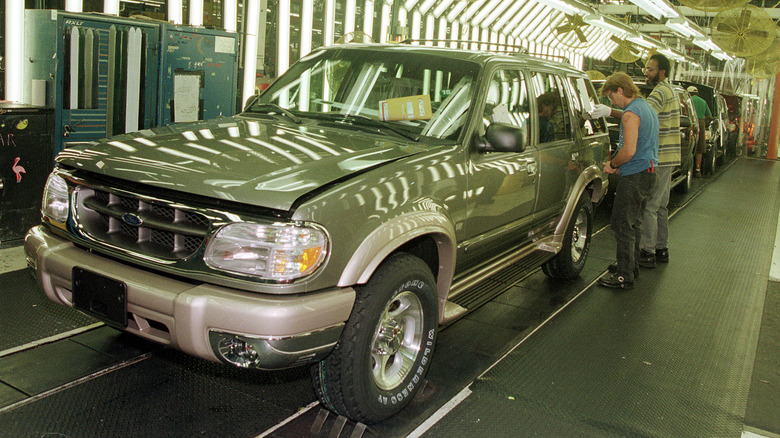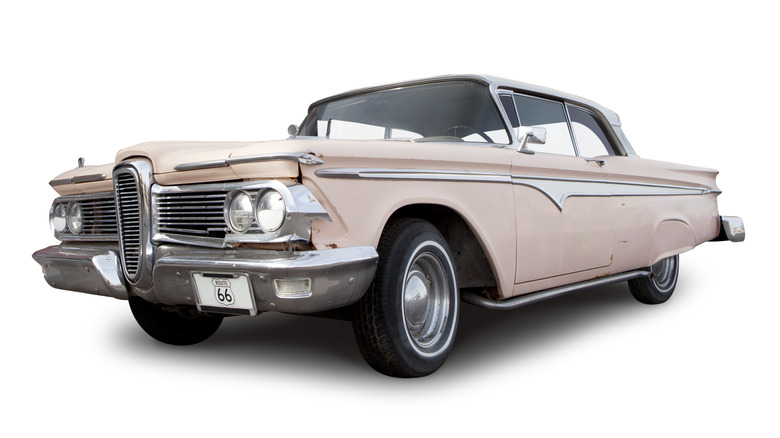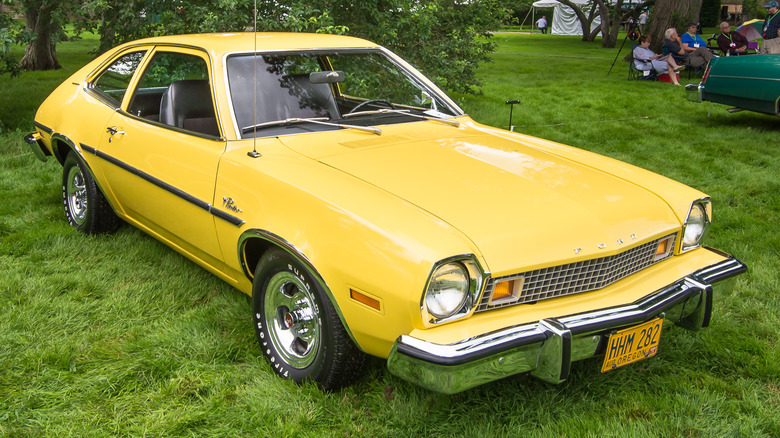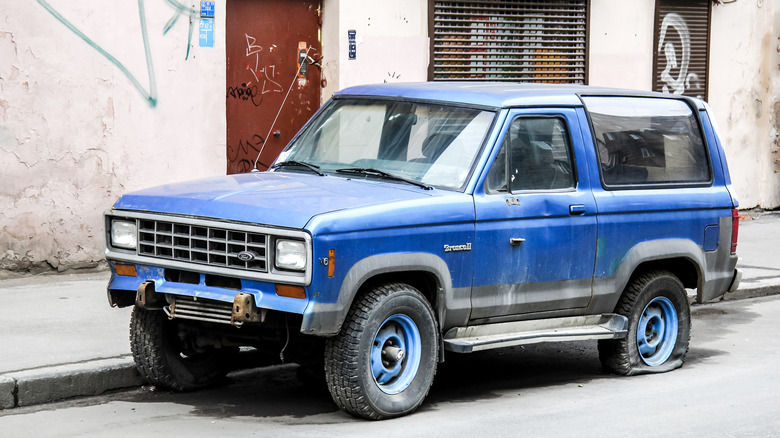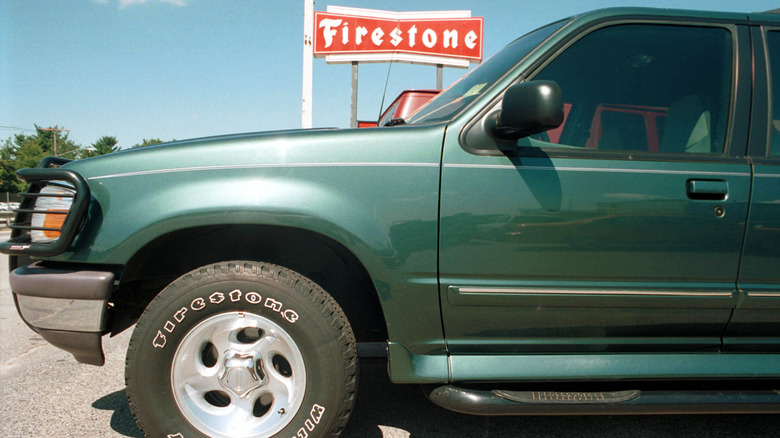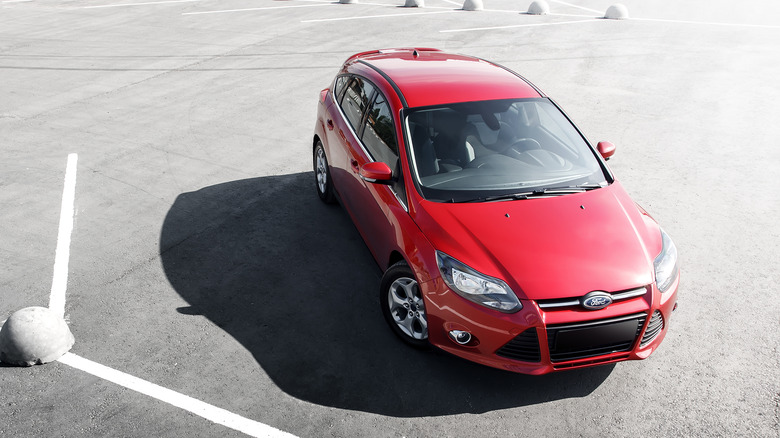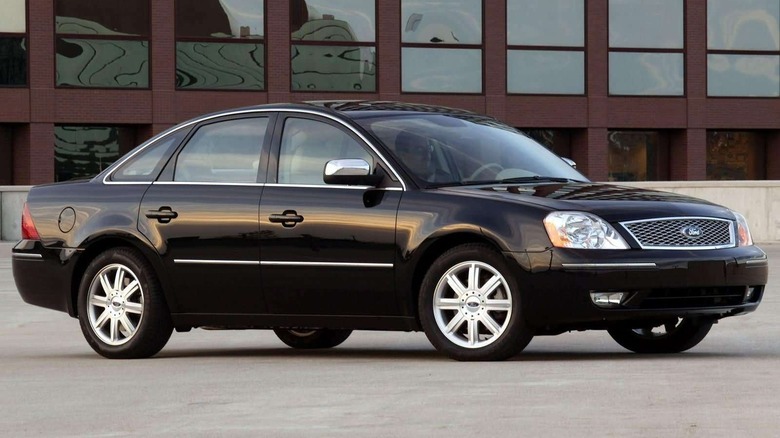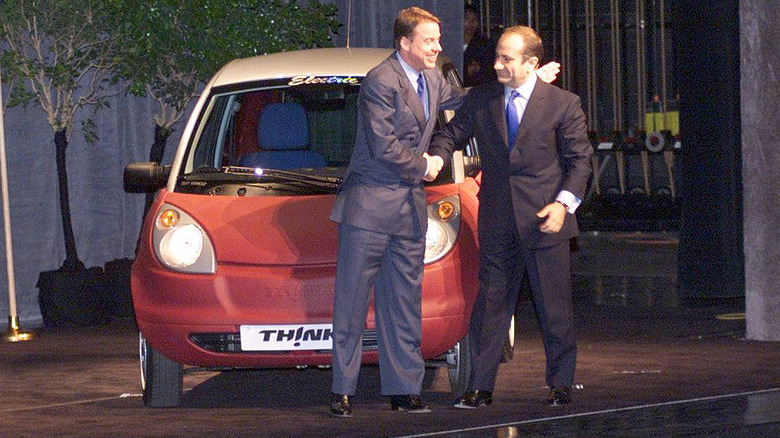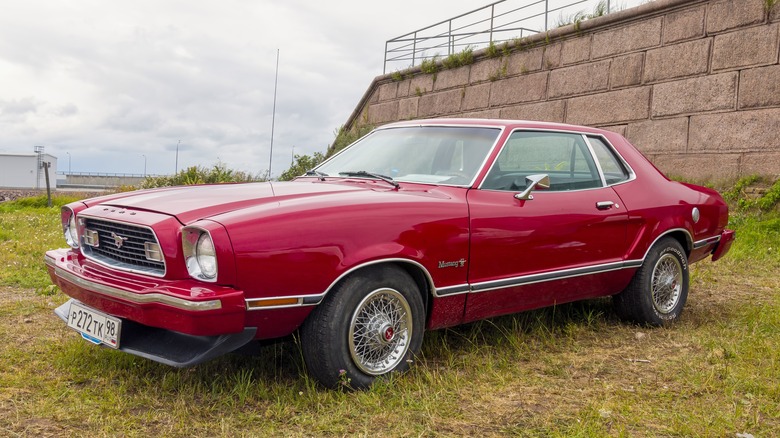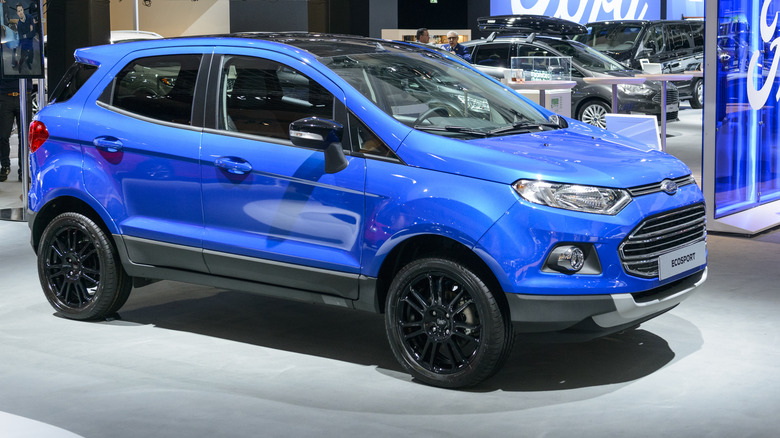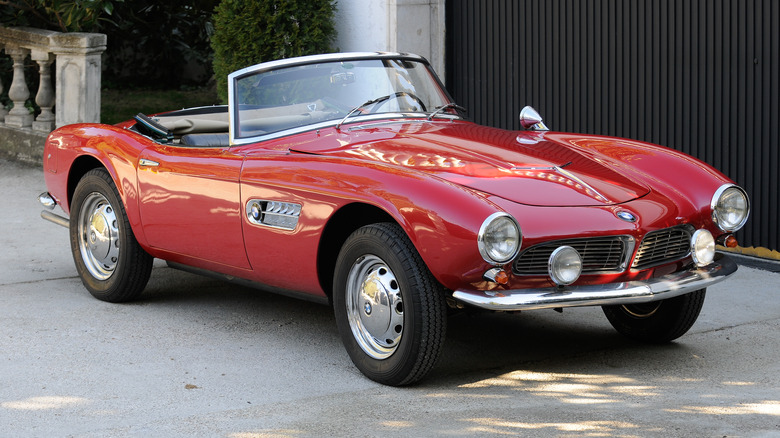Ford's Biggest Car Flops Of All Time
Ever since Henry Ford revolutionized car manufacturing with the debut of the Model T in 1908, his eponymous car company has remained one of the world's most influential automotive brands. Ford has produced some of the most revered nameplates in American automaking history, with the Mustang retaining its crown as the world's best-selling sports car nearly six decades after it first launched. The brand also has plenty of iconic cars that have been consigned to the archives, with enthusiasts itching for them to make a modern comeback. However, for every Thunderbird, Gran Torino, or RS200, there are an equal number of Ford models that deserve to remain in the past.
Some were defective, some were sales disasters, and some were simply terrible to drive. There are even a few flops that Ford would really prefer no one remembered, especially in cases where the company was proven to be lying to customers with sometimes deadly consequences. Whatever the reason they failed, these nine cars all represent the low points of Ford Motor Company's extensive automaking history.
Ford's Edsel division
If you were to ask most Ford fans what the biggest flop in the company's history was, the answer would almost always remain the same: Edsel. Ford's market research throughout the mid-'50s had shown that there was a gap in the company's lineup, between the budget-oriented Ford brand and the luxurious Mercury. A task force, dubbed the Whiz Kids, was established to fill the gap, and the resulting mid-tier brand was named after Henry Ford's son, Edsel (via Road and Track). The new marque debuted in 1957 amid a huge marketing push from Ford, but the hype quickly died down, and sales numbers plummeted.
To add to the company's woes, the first batch of Edsel cars was beset with production issues, and an economic recession a year after the brand's launch caused consumers to lose interest in the mid-tier "premium" car sector. The division was eventually scrapped in 1959, leaving Ford with catastrophic losses and public humiliation.
Ford Pinto
The Pinto gained a reputation as one of Ford's worst models not only because of its disastrous design flaw, but also because of the callous way the company treated the customers who bought it. Its nickname as "the barbecue that seats four" was coined in response to reports that in an accident, the Pinto's rear-mounted gas tank could rupture and explode. It was found that even relatively minor accidents could trigger an explosion, but as it turned out, Ford already knew about all of this.
The company had picked up the fact that the car was a potential death trap during testing, but had calculated that the estimated cost of paying out for wrongful death lawsuits was lower than the cost of fixing the problem. So, it sold customers the Pinto knowing that some of them would burn to death, but not enough of them to warrant doing anything about it. As it turned out, the problem was worse than Ford initially thought, and an estimated 9,000 people died because of the defect.
Ford Bronco II
Despite its initial commercial and critical success, the Ford Bronco II had one flaw that turned it into a rolling death trap. The Bronco II was designed as the compact, two-door version of the Bronco, and was based on the Ranger pickup (via MotorTrend). Its tall, boxy proportions made it vulnerable to rollovers, an issue that it later emerged Ford had discovered during testing. Engineers suggested a variety of fixes for the problem, but executives decided to just release the car in its current state, as every fix was deemed too costly or time-consuming.
Reports of fatalities caused by the Bronco II rolling over during accidents soon began to pour in, and it was only a matter of time before news emerged that Ford had already known about the problem before launch. A slew of lawsuits ensued, which reportedly cost the company over $2.4 billion in settlements. In total, 260 deaths were officially attributed to the rollovers, making this one of the deadliest defects in American automaking history.
Ford Explorer
With the disasters that were the Pinto and the Bronco II, you might think Ford would have learned from its mistakes. It went on to launch the Ford Explorer with another deadly defect despite engineers reporting concerns about the problem before production. It turned out that the Explorer was, like the Bronco II, also unusually prone to rollovers, but that issue was initially unknown to the public when reports began to emerge of the truck's Firestone tires failing at an alarming rate. A recall was issued, and Ford initially tried to pin the blame on Firestone, reports Time. Firestone responded with its own accusations against Ford, suggesting a design flaw with the Explorer was to blame since its tires were used on other Ford models with no issues.
After further back and forth between the two parties, Firestone eventually ended up taking most of the blame, but not before 174 deaths and over 700 serious injuries had been caused by the defect. These figures might have been slightly understated, too, as a report by the NHTSA found that several hundred thousand tires were still in circulation five years after the initial recall.
Ford Focus' dual-clutch transmission
While the Ford Focus itself has plenty of fans, particularly in Europe where it remains a strong seller despite a diminishing market for hatchbacks, the car's DPS6 dual-clutch transmission was an abject failure. Focuses built between 2012 and 2016, along with Fiestas built between 2011 and 2016, suffered from multiple issues with the transmission. This could include "shuddering, slipping, bucking, jerking, hesitation while changing gears, premature internal wear, delays in downshifting and, in some cases, sudden or delayed acceleration," according to a lawsuit filed against the automaker.
Ford eventually agreed to extend the warranty of affected cars in response to the claims, but only after further reports emerged that the company had known about the defect for years but ignored it to shift inventory (via Jalopnik). Not only that, but it had issued secret instructions for dealers to fix the fault behind customers' backs. All in all, a very damaging episode for Ford, and one that potentially cost the automaker not only a lot of money in the short term but also the loss of scores of repeat customers.
Ford Five Hundred
While it wasn't an all-out disaster like some of the other cars here, the Ford Five Hundred is symbolic of the company's reluctance to take any risk throughout the mid-Noughties, and the stagnation of its sedan lineup as a result. It's about as unexciting as it's possible to make a family hauler, with a bland design, a sluggish transmission that one reviewer described as just "oozing forward," and an ancient V6 plucked straight from the previous-generation Taurus. The interior space was generous, the economy was reasonable, and it was okay (if never enjoyable) to drive. But, there was little reason to remember the car ever existed, never mind buying one.
Keep in mind, too, that the Five Hundred was released at a time when SUVs were beginning to gain market share at a rapid pace, at the expense of the likes of Ford's own Taurus. Ford needed something exciting to draw attention back to its range of sedans, but this is all it could manage. Around the same time, Chrysler unveiled the 300C, which has been successful enough that it has remained in production for 17 years, finally getting the ax after the 2023 model year. The 300C and Five Hundred were direct competitors, but thanks to its unrelenting blandness, it was axed after just three years.
Ford Th!nk City
Ford might have drawn plenty of headlines (and controversy) with the launch of its Mustang Mach-E and F-150 Lightning EVs, but its earlier electric vehicle efforts were just as controversial. Back in the mid-1990s, a Norwegian startup called Pivco had developed an electric microcar, but lacked the funds to get it into production (via The Drive). Ford came to the fledgling automaker's rescue and bought up a majority stake in the company, rebranding the microcar as the Ford Th!nk City. It launched officially at the 2000 North American International Auto Show, and production began shortly after.
Just two years later, the car was axed, with only 1,005 cars built. Ford sold its stake in the company in 2003, having spent well over $100 million in development costs (via Car Magazine). The Th!nk City was doomed to fail in America, as pint-sized EVs with puny ranges and low top speeds were simply just not practical for most American drivers. Even so, it's a shame Ford didn't put more effort into marketing the Th!nk City in Europe, as it might have proved more successful in the cramped, narrow streets of many European cities where demand for small cars is consistently higher.
Ford Mustang II
Every generation of the Mustang has its selling points and drawbacks, but it's largely agreed that the Mustang II is the worst of them all. Built on the underpinnings of the Ford Pinto, executives decided to ax the previous generation car's V8 in favor of a four-cylinder and a V6 for the Mustang II. A V8 variant was eventually unveiled in 1975, but with restrictive emissions regulations, it could only produce 140 horsepower.
That made it one of the slowest Mustangs ever made, yet it's easy to forget that, at the time of its release, it was actually quite popular. Ford's president at the time, Lee Iacocca, acknowledged that the first-gen Mustang had been getting more bloated every year since it originally launched, leading customers to demand a smaller, lighter car (via MotorTrend). The Mustang II was exactly that, and even if it was flawed from a performance perspective, the oil crisis that gripped the country at the time ensured that a much more powerful car would never have met regulations anyway. Over time, the Mustang II has become the poster child for the shortcomings of the "malaise era," and while it's undoubtedly a flop in both pure sports car terms and as a Mustang, it's mostly just a product of its time rather than a full-on failure on Ford's part.
Ford EcoSport
Ford's plan of axing its smaller cars, even its best-selling ones, in favor of SUVs and crossovers might be a riskier strategy than the company's board thinks. Sure, buyers favor those body styles over traditional sedans and hatchbacks. The thing is, Ford's recently-axed small EcoSport SUV simply wasn't any good, and its sales numbers reflected that. Ford only managed to sell around 60,000 examples in 2020, and numbers declined further in 2021. It's no surprise, then, that it was axed in mid-2022.
Many reviewers unlucky enough to be tasked with writing about the EcoSport came to the same conclusions. Car and Driver called it "dead last in its competitive class," while across the pond, Auto Express noted the car's "poor interior quality" and "uninspiring road manners." Driving Line even suggested it might be "the worst new car in America" shortly before it was axed. If this is the quality of small car that buyers can expect after Ford axes its remaining global lineup of hatchbacks and superminis, then there's a risk that buyers simply won't return to the Blue Oval like the company's management expects them to.
BMW has some equally disastrous flops
While Ford has had more than its fair share of flops over the years, it's only fair to point out that it's far from the only automaker that's put out some serious duds. Even enthusiasts' favorites like BMW aren't immune from the occasional misstep, with the likes of the BMW 507 and M1 supercar losing the company vast amounts of money due to low sales. Both models might be collectors' items today, but they flopped hard when they first launched, with the 507 selling less than 250 units before facing the chop.
Even some of BMW's more recent cars have been plagued with issues, with the i8's performance failing to live up to its supercar looks and the E60 M5's appeal being tainted by its unreliable V10 engine. Anyone looking to learn more about the biggest failures to emerge from Bavaria should check out our roundup of the biggest BMW flops of all time, which includes one controversial choice that not every enthusiast will agree with.
